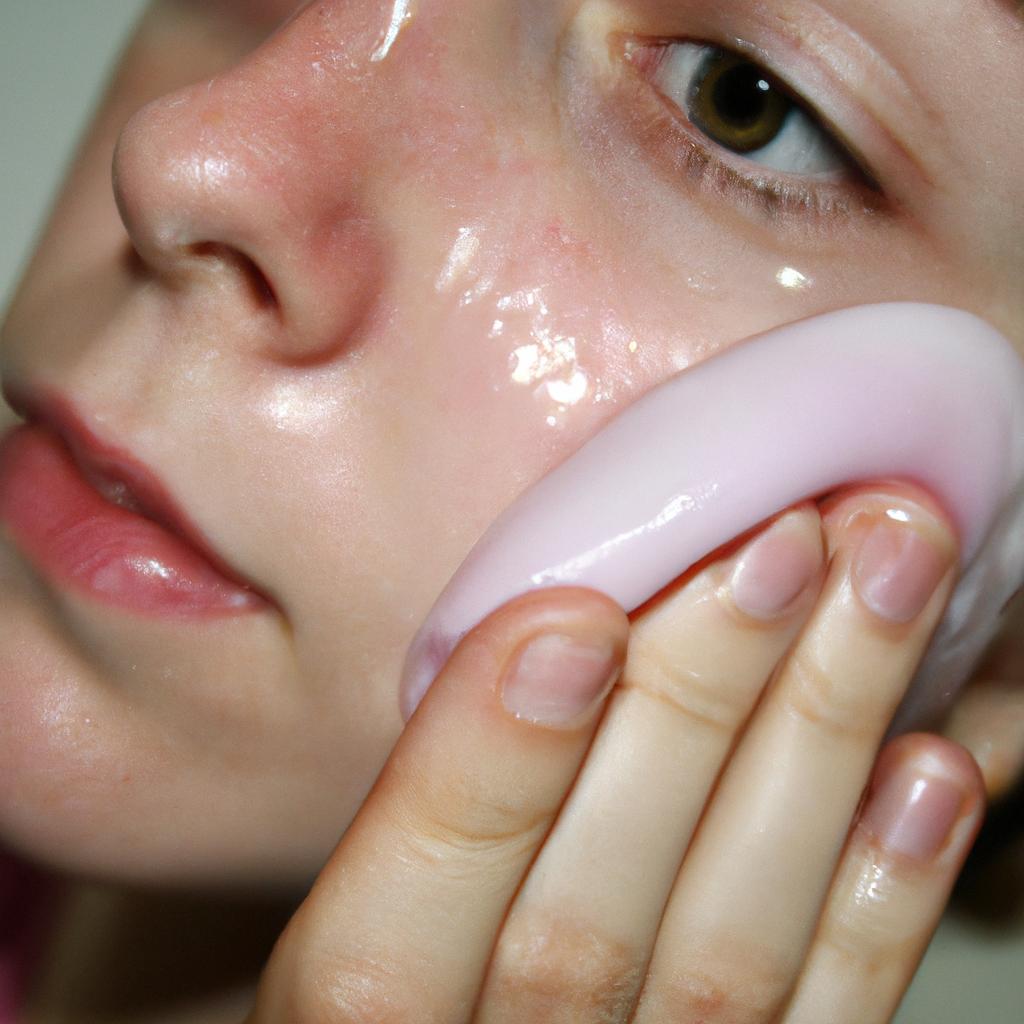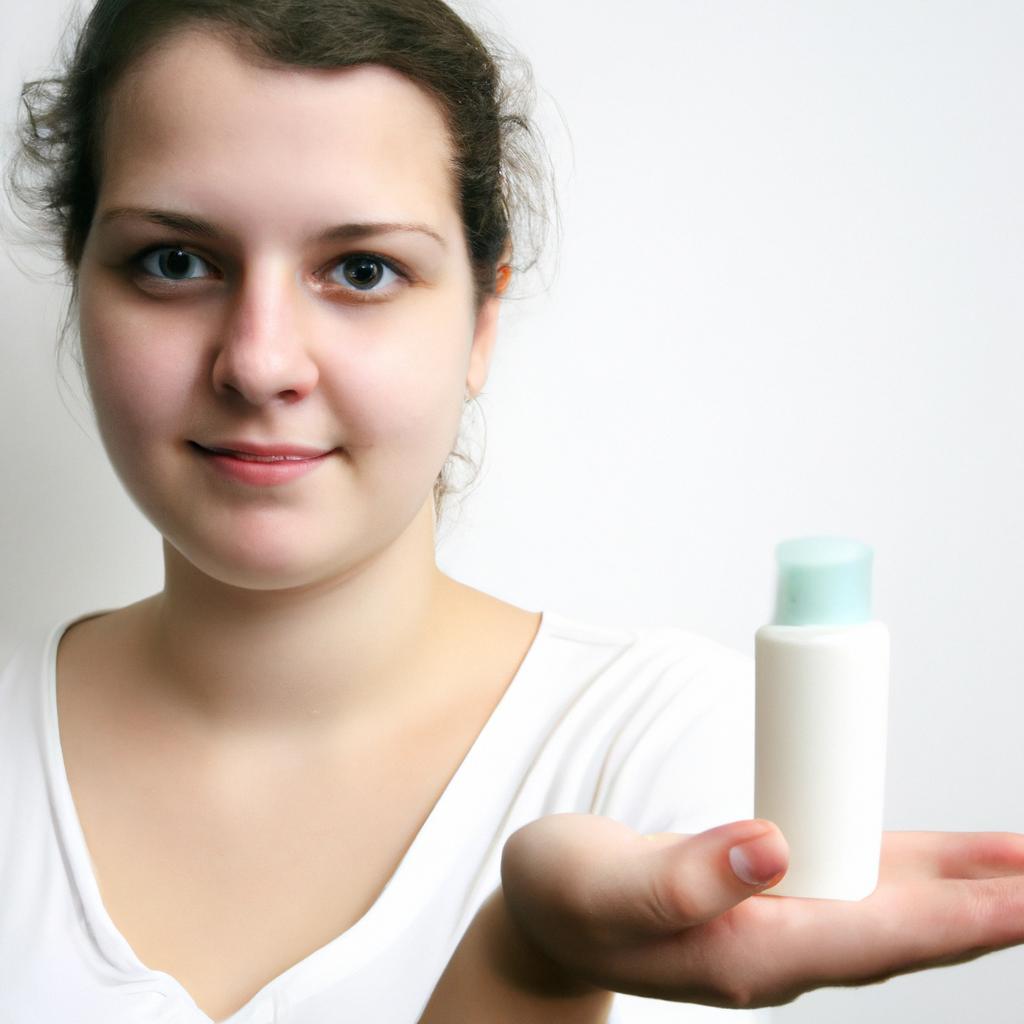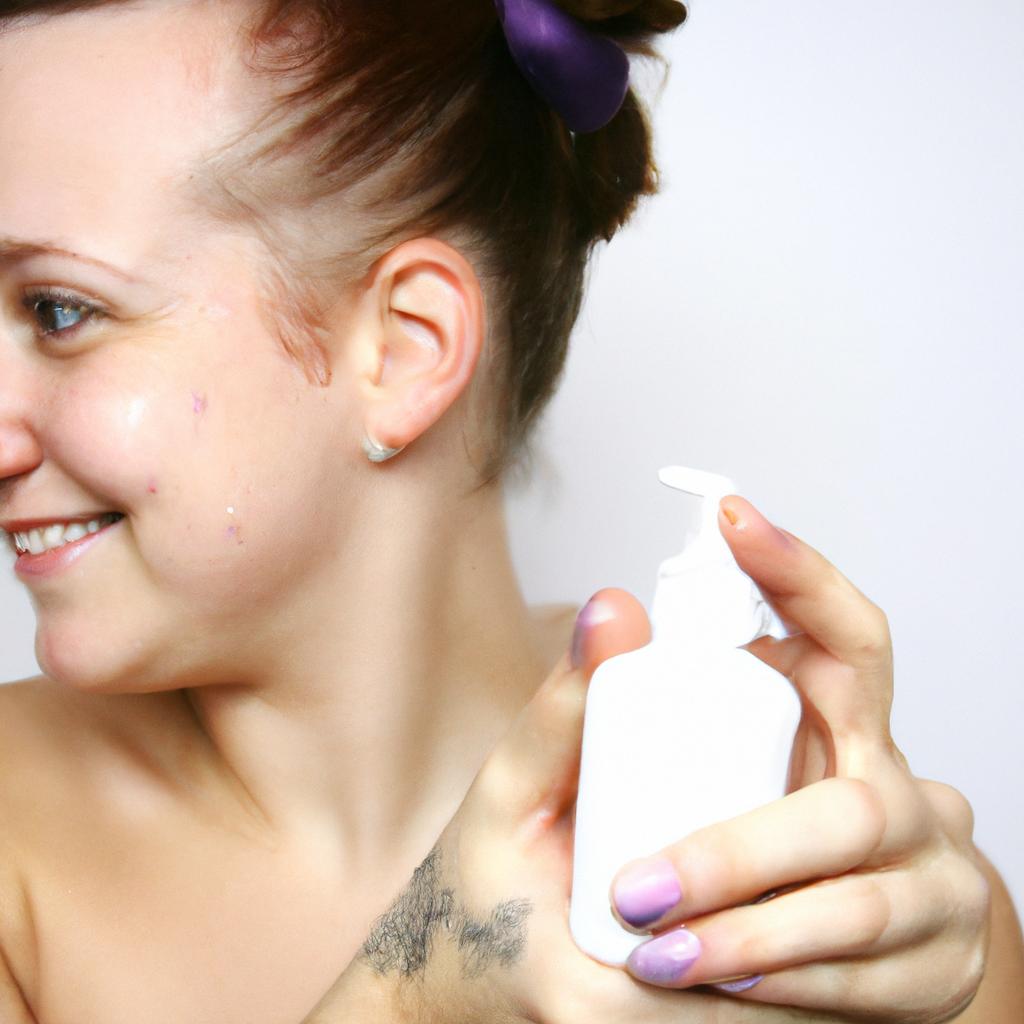Skin care products have become an integral part of our daily routines, promising to enhance the health and appearance of our skin. However, simply applying these products without understanding their proper usage can lead to ineffective results or even adverse effects. This article aims to explore the key factors involved in effective application of skin care products, emphasizing the importance of following recommended guidelines for optimal outcomes.
Consider the case of Sarah, a 35-year-old woman who recently purchased a high-end moisturizer boasting remarkable anti-aging properties. Excited about its potential benefits, she applied it generously every night before bed. Despite her diligence, Sarah noticed no visible improvement in her skin’s texture or overall appearance after weeks of use. In this example, Sarah’s lackluster results highlight the significance of not only selecting appropriate skin care products but also correctly applying them according to specific recommendations and instructions provided by manufacturers or dermatologists.
To maximize the effectiveness of skin care products, it is essential to understand how different factors such as product formulation, method of application, timing, and frequency can influence their performance on our skin. By addressing these aspects with precision and knowledge, individuals can harness the full potential of their chosen skincare regimen and achieve desired outcomes effectively while avoiding unnecessary setbacks. Through a comprehensive exploration of product formulation, individuals can gain insight into the specific ingredients and their intended effects. For example, some products may contain active ingredients like retinol or hyaluronic acid, which require special attention regarding dosage and frequency of application for optimal results.
Next, understanding the correct method of application is crucial. Many skincare products recommend gentle massaging or patting motions to ensure proper absorption into the skin. Neglecting this step or applying products too vigorously can hinder absorption and reduce effectiveness.
Timing also plays a role in maximizing product efficacy. Some products are designed to be used at specific times of day or in conjunction with other products for enhanced benefits. Following these recommendations can help users achieve desired outcomes more efficiently.
Lastly, adhering to the recommended frequency of use is vital. Overusing or underusing skincare products can lead to suboptimal results. It is essential to strike a balance between consistency and moderation to allow time for the product’s effects to manifest without overwhelming the skin.
In conclusion, effective application of skincare products involves considering factors such as product formulation, method of application, timing, and frequency. By diligently following recommended guidelines provided by manufacturers or dermatologists, individuals can harness the full potential of their chosen skincare regimen and achieve optimal outcomes for healthier and more radiant skin.
Understanding Your Skin Type
Imagine a scenario where two individuals with different skin types are using the same skincare products. Person A has oily, acne-prone skin, while person B has dry and sensitive skin. Despite using the identical product, person A experiences breakouts and excessive oiliness, whereas person B suffers from redness and irritation. This example highlights the crucial role of understanding your unique skin type when it comes to applying skincare products effectively.
To determine your skin type, consider these factors:
-
Sebum production: Take note of how much oil your skin produces throughout the day. Oily skin tends to have excess sebum secretion, resulting in a shiny appearance even shortly after cleansing. Conversely, dry skin often lacks natural oils and may feel tight or flaky.
-
Sensitivity: Pay attention to any adverse reactions your skin exhibits upon exposure to certain ingredients or environmental factors. Sensitive skin is prone to redness, itching, or stinging sensations when encountering irritants.
-
Hydration levels: Assess whether your skin feels moisturized and plump or dehydrated and dull. Well-hydrated skin maintains its elasticity and appears radiant, while dehydrated skin may exhibit rough patches or fine lines.
-
Pore size: Observe the size of your pores on various parts of your face. Larger pores tend to be more prevalent in oily or combination (oily in the T-zone but drier elsewhere) skin types, whereas smaller pores are commonly seen in those with normal or dry skin.
By understanding your specific skin type based on these indicators, you can tailor your skincare routine accordingly for optimal results.
Consider this bullet point list as a gentle reminder:
- Each individual’s complexion is unique.
- Skincare products that work well for others might not suit your particular needs.
- Identifying your own specific concerns will help target them effectively.
- Consulting a dermatologist can provide valuable insights into your skin type and concerns.
| Skin Type | Characteristics | Common Concerns | Recommended Products |
|---|---|---|---|
| Oily | Excess sebum production | Acne breakouts | Lightweight, oil-free cleansers |
| Dry | Lack of natural oils | Flaky or rough texture | Rich moisturizers with hydrators |
| Combination | Oiliness in T-zone, dryness elsewhere | Enlarged pores on T-zone | Dual-action products for both areas |
| Sensitive | Reactivity to irritants | Redness or irritation | Fragrance-free, hypoallergenic formulations |
Understanding your skin type lays a solid foundation for effective skincare. In the subsequent section about “Identifying Your Skin Concerns,” we will delve deeper into how recognizing specific issues can help you choose the most suitable skincare regimen to address them effectively.
Identifying Your Skin Concerns
Section Title: Applying Skin Care Products: The Key to Effective Usage
Understanding your skin type is crucial in order to select the right products that will address your specific needs. Now, let’s move on to identifying your skin concerns and how you can effectively apply skincare products to achieve optimal results.
To illustrate the importance of addressing individual skin concerns, consider a hypothetical scenario where two individuals both have oily skin. However, one person also struggles with acne while the other has fine lines and wrinkles. Although they share a common skin type, their concerns differ significantly. This highlights the need for targeted solutions tailored to each person’s unique set of challenges.
When it comes to applying skincare products, there are several key considerations that can enhance effectiveness and ensure maximum benefits:
-
Cleanse thoroughly: Before applying any product, make sure your face is clean and free from dirt or makeup residue. Properly cleansing helps prepare your skin for better absorption of subsequent products.
-
Use gentle motions: When applying serums, moisturizers, or creams, use light upward strokes instead of vigorous rubbing. Gentle motions minimize unnecessary stretching or tugging on delicate facial tissue.
-
Allow time for absorption: Give each product enough time to absorb into the skin before layering another one on top. Waiting a few minutes between applications allows ingredients to penetrate deeper for improved efficacy.
-
Follow instructions carefully: Different products may require different application techniques or frequencies. Always read labels and follow manufacturer instructions meticulously for best results.
By following these guidelines when applying skincare products, you can optimize their effectiveness and increase your chances of achieving desired outcomes.
Next Section: Cleansing Your Face Properly
Cleansing Your Face Properly
Understanding your skin concerns is essential before delving into a skincare routine. By identifying specific issues, you can tailor your products and treatments to address them effectively. Let’s now explore how to cleanse your face properly, which serves as a crucial foundation for achieving healthy and radiant skin.
Imagine waking up with oily skin, visible pores, and occasional breakouts that leave you feeling self-conscious throughout the day. This scenario highlights the importance of proper facial cleansing techniques in maintaining clear and balanced skin. Follow these steps to ensure an effective cleansing routine:
-
Choose the right cleanser:
- Consider your skin type (e.g., dry, oily, combination) when selecting a cleanser.
- Opt for gentle formulas that do not strip away natural oils but still remove impurities effectively.
- Look for ingredients like salicylic acid or benzoyl peroxide if you have acne-prone skin.
- Avoid harsh soaps or cleansers containing alcohol, as they may cause irritation.
-
Wash your face twice daily:
- Start by wetting your face with lukewarm water; avoid hot water as it can be drying.
- Apply a small amount of cleanser onto your fingertips or a clean washcloth.
- Gently massage the cleanser onto your face using circular motions for about 30 seconds.
- Rinse thoroughly with lukewarm water until all traces of cleanser are gone.
-
Pat dry instead of rubbing:
- After rinsing off the cleanser, gently pat your face dry with a soft towel.
- Avoid rubbing vigorously, as this can irritate the skin and lead to redness or inflammation.
-
Follow up with toner (optional):
- If desired, apply a toner after cleansing to remove any remaining impurities and balance the skin’s pH level.
- Look for toners with ingredients like witch hazel or rose water, known for their calming properties.
By incorporating these cleansing practices into your skincare routine, you can effectively remove dirt, excess oil, and makeup residue from your face. This sets the stage for better product absorption and allows subsequent steps in your regimen to work more efficiently.
Now that we have covered proper facial cleansing techniques let’s delve into another crucial step – applying moisturizer correctly.
Applying Moisturizer Correctly
Transitioning seamlessly from the proper cleansing of your face, let’s now delve into another crucial step in your skincare routine – applying moisturizer correctly. To illustrate this point, consider the following scenario: Sarah diligently cleanses her face every morning and night, only to apply her moisturizer haphazardly without realizing its significance. As a result, she struggles with dry patches and an uneven complexion.
To ensure optimal results from your moisturizing efforts, follow these key guidelines:
-
Choose the right moisturizer for your skin type:
- Dry skin types may benefit from thicker creams or oil-based formulations.
- Oily or acne-prone skin can generally opt for lighter lotions or gel-based moisturizers.
- Combination skin might require different products for specific areas (e.g., a lightweight lotion for oily zones and a heavier cream for drier regions).
-
Apply the moisturizer on damp skin:
- After cleansing your face, gently pat it dry with a soft towel, leaving some moisture behind.
- Applying moisturizer on slightly damp skin helps lock in hydration more effectively.
-
Use gentle upward motions:
- Start by taking a small amount of product onto clean fingertips.
- Using gentle circular motions, spread the moisturizer evenly across your face and neck area.
- Avoid tugging or pulling at the skin; instead, use upward strokes to counteract gravity’s effects over time.
-
Don’t forget about sunscreen:
- If you’re applying moisturizer during daytime hours, choose one that includes SPF protection to shield against harmful UV rays.
Let’s further emphasize the importance of proper moisturization through an emotional appeal:
| Column 1 | Column 2 | Column 3 | Column 4 |
|---|---|---|---|
| Dryness | Elasticity | Radiance | Comfort |
| Reduced | Improved | Enhanced | Luxurious |
| Tightness | Supple | Glowing | Nourished |
By following these guidelines and incorporating a suitable moisturizer into your skincare routine, you can experience the benefits of improved hydration, enhanced skin elasticity, radiant complexion, and overall comfort. With each application, visualize the positive transformation happening within your skin.
Transitioning seamlessly into the subsequent section about “Incorporating Serums and Treatments,” it is important to understand how different products work synergistically to maximize their effectiveness in achieving healthy skin.
Incorporating Serums and Treatments
Transitioning from the previous section about applying moisturizer correctly, let us now delve into the importance of incorporating serums and treatments into your skincare routine. To illustrate this point, consider the case of Sarah, a 35-year-old woman who has been struggling with hyperpigmentation on her face. Despite diligently following a basic skincare regimen that includes cleansing and moisturizing, she noticed minimal improvement in her skin’s appearance. This prompted her to seek additional solutions.
Incorporating serums and treatments can provide targeted benefits for specific skin concerns. These products are formulated with higher concentrations of active ingredients, allowing them to penetrate deeper into the skin. For example, using a vitamin C serum may help brighten dull complexions by reducing dark spots caused by sun damage or acne scars. By adding serums and treatments tailored to their individual needs, individuals like Sarah can enhance the effectiveness of their skincare routines.
To maximize the efficacy of these specialized products, it is crucial to follow some guidelines:
- Start with clean skin: Before applying any serum or treatment, ensure that your face is thoroughly cleansed and free from dirt or makeup residue.
- Follow product instructions: Each serum or treatment will have specific usage instructions provided by the manufacturer. It is important to read and adhere to these guidelines for optimal results.
- Use appropriate amounts: Apply only the recommended amount of product as excessive use may irritate or overwhelm the skin.
- Patience is key: Results from serums and treatments may not be immediate; consistent use over time is necessary to see noticeable improvements.
By incorporating these steps into your skincare routine, you can harness the potential benefits offered by serums and treatments more effectively. Keep in mind that different individuals may require different types of products based on their unique skin concerns.
Now that we have explored how serums and treatments can elevate your skincare routine, let us move on to discussing another vital aspect—protecting your skin from harmful UV rays.
Protecting Your Skin from the Sun
Building upon our discussion of incorporating serums and treatments into your skincare routine, let us now explore another vital aspect of effective usage – protecting your skin from the sun. By understanding the importance of safeguarding your skin against harmful UV rays, you can maintain its health and prevent potential damage. Consider this hypothetical scenario: Sarah diligently applies her favorite serum every morning but neglects to protect her skin from the sun’s harsh rays. Despite experiencing positive results initially, she starts noticing signs of premature aging due to prolonged unprotected exposure.
Bullet Point List (Emotional appeal):
- Shielding your skin from the sun is crucial for preventing wrinkles, fine lines, and age spots.
- Regular use of sunscreen helps lower the risk of developing skin cancer caused by harmful ultraviolet radiation.
- Maintaining a consistent sun protection routine promotes an even complexion and prevents discoloration.
- Taking proactive measures to shield your skin preserves its youthful appearance and overall health.
Table (Emotional appeal):
| Protection Level | SPF Rating | Recommended Use |
|---|---|---|
| Low | 15 | Everyday |
| Medium | 30 | Outdoor activities or extended sun exposure |
| High | 50+ | Intense sunlight or during peak hours |
Incorporating these recommendations will help ensure that you are adequately protected against UV radiations at all times.
To effectively shield your skin from the sun:
- Choose a broad-spectrum sunscreen with an appropriate SPF rating according to your needs.
- Apply sunscreen generously on exposed areas at least 15 minutes before stepping outside.
- Reapply every two hours when spending prolonged periods in direct sunlight or after swimming/sweating excessively.
- Don’t forget to protect often overlooked areas like your ears, neck, and the back of your hands.
By following these guidelines and incorporating sun protection into your skincare routine, you can maintain a healthy complexion and minimize the risk of sun damage.
Remember that effective usage of skincare products involves more than just using serums and treatments; it also entails safeguarding your skin from harmful UV rays. By prioritizing sun protection alongside other components in your routine, you can optimize the health and appearance of your skin for years to come.
 Stanley Beauty Care
Stanley Beauty Care



